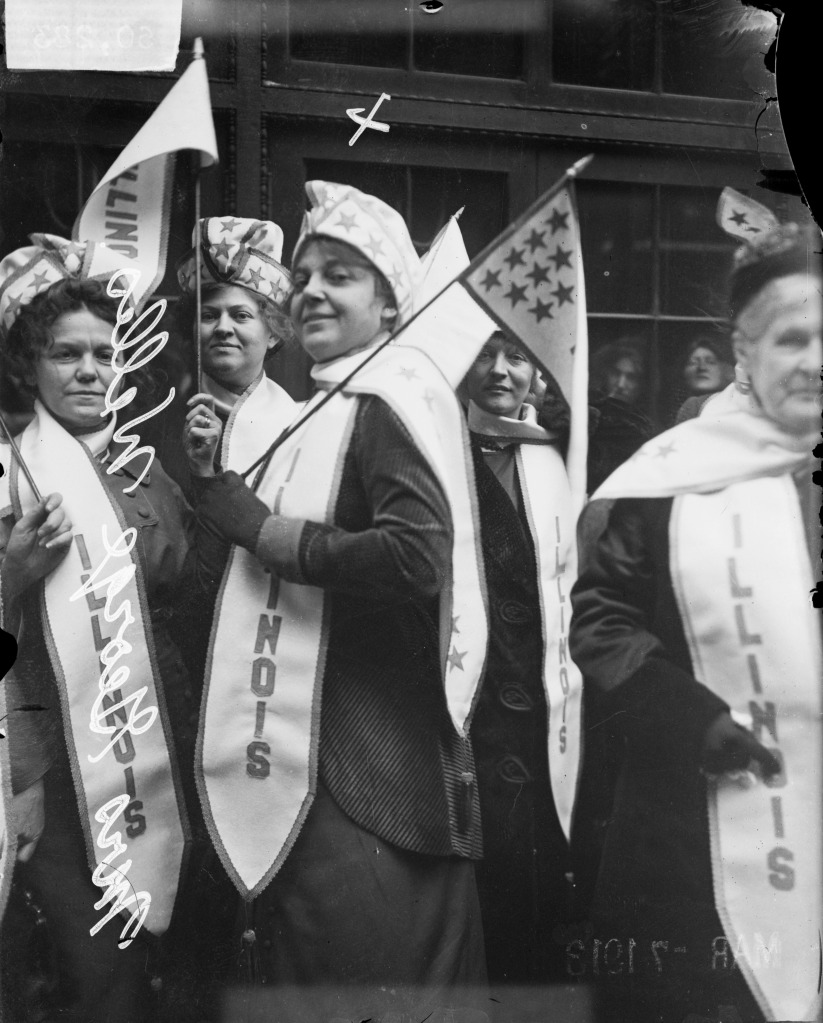By Jennifer Duvall – Loyola University Chicago, Masters in Public History Program, Fall 2019.

In March of 1919, the United States was sitting on the edge of a new era for women. The long struggle for suffrage was coming to a close due to a swell of support after the passage of the 19th Amendment, or, as it was more commonly known, the Susan B. Anthony Amendment, by the House of Representatives. As the women of the National American Woman Suffrage Association (NAWSA) prepared for their national convention in St. Louis, they faced a decision about the future of the association after their current goal was achieved. After spending the last fifty years protesting and fighting for the right to vote and a more equal place in American society, this group of women crusaders had to determine their next move. When the convention opened on March 23, 1919, their plan for the future was launched. Mrs. Carrie Chapman Catt, the national president of the suffragist organization, announced plans to launch a league of women voters [1].
As with many new endeavors, rumors and false reports caused a great deal of confusion among the women at the convention. The biggest roadblock, however, was the belief that Mrs. Catt intended to use the league to create a new political party. This false assumption caused quite an uproar but was soon laid to rest when it was declared that the new league would neither affiliate with nor endorse any politicians or political parties [2]. Mrs. Catt expressed her desires to have the new organization help create an America that was both industrially and civilly successful: “The first object of the new organization should be to secure the final enfranchisement of women in the United States. The second object should be to aid in the freedom of women in other lands; the third to remove legal discriminations against women, and the last to stabilize the democracy of the nation” [3]. The women were asked to commit to the league for at least five years in order to establish it and get the different committees up and running. With the existing membership of approximately 2,500,000, the league might hold enough votes to be able to accomplish many of its goals through political channels rather than protests [4].

In addition to this new association, huge strides were to be made in the coming months to accomplish the suffragists’ original goal. During the convention itself, the women of Missouri were granted presidential suffrage, and the good news did not stop there [5]. On June 4, 1919, after many close calls, the Senate finally passed the 19th Amendment, and just six days later, on June 10, 1919, Illinois became the first state to ratify it. The work at the convention to start the League of Women Voters was more important now than ever. NAWSA’s accomplishments were there for the whole world to see, and members recognized that there was still much left to do.
The women continued working throughout the year to obtain ratification of the 19th Amendment in their respective states as well as to create a new organization through which they could continue their work for women, children, and society as a whole. On February 14, 1920, the Victory Convention of the National American Woman Suffrage Association was held in Chicago, Illinois. The goals of the convention were to celebrate their impending victory in gaining the vote nationwide, to decide whether to disband the suffrage association if it was no longer needed, and to officially inaugurate the National League of Women Voters [6]. There were many very important decisions to be made during the 1920 convention, not the least of which was the focus of the new organization. The long list of issues identified at the convention was wide-ranging, involving “child welfare, education, the home and high prices, women in gainful occupations, public health and morals, and independent citizenship for married women.” [7].

Planning questions for the Executive Council Meeting in the 1920 convention program.
The crusade for suffrage had ended and a new era had begun. This convention marked the beginning of a one-hundred-year tradition of women fighting for and supporting other women through the National League of Women Voters.
Notes
[1] Fanny Butcher. Woman Voters’ League Plan of Jubilee Session: Some Suffragists Demur . . . Chicago Daily Tribune (1872-1922). Mar 25 1919. ProQuest Historical Newspapers: Chicago Tribune, Pg. 9
[2] Ibid.
[3] Ibid.
[4] Ibid.
[5] Fanny Butcher. Women Cheer News of New Vote Victory. Chicago Daily Tribune (1872-1922). Mar 29, 1919. ProQuest Historical Newspapers: Chicago Tribune, Pg. 12.
[6] Fanny Butcher. Chicago Today Suffrage Hub of the Nation. Chicago Daily Tribune (1872-1922). Feb 12, 1920. ProQuest Historical Newspapers: Chicago Tribune, Pg. 7.
[7] League of Women Voters of the United States, https//lwv.org/Illinois/Chicago/history.
Bibliography
Butcher, Fanny. Chicago Today Suffrage Hub of the Nation. Chicago Daily Tribune (1872-1922). Feb 12, 1920. ProQuest Historical Newspapers: Chicago Tribune, 7.
Butcher, Fanny. Suffrage Resolution Favors Voters’ League on Nonpartisan Lines. Chicago Daily Tribune (1872-1922). Mar 26, 1919. ProQuest Historical Newspapers: Chicago Tribune, 17.
Butcher, Fanny. Woman Voters’ League Plan of Jubilee Session: Some Suffragists Demur . . . Chicago Daily Tribune (1872-1922). Mar 25 1919. ProQuest Historical Newspapers: Chicago Tribune, 9
Butcher, Fanny. Women Cheer News of New Vote Victory. Chicago Daily Tribune (1872-1922). Mar 29, 1919. ProQuest Historical Newspapers: Chicago Tribune, 12.
“History,” League of Women Voters of the United States, last modified October 17, 2019, https://www.lwv.org/about-us/history
